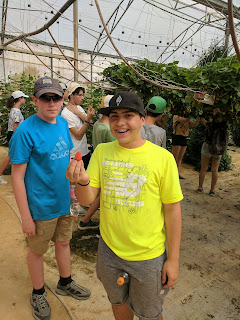According to a few of
the botanists we've met in the Negev thus far, the sweetest tomatoes grow in
salty water like that of the early days of Be'er Sheva. That's where Tomer's
from, too! So take that for what it's worth...
You can think of our
trip to the Negev as three key encounters:
1) Encounters with the
people
2) Encounters with the
rocks
3) Encounters with
vegetables
It started Sunday
morning with an orientation at Sha’ar LaNegev – The Gates of the Negev
institute of Be’er Sheva. It was an interactive introduction to the idea of the
Negev, the importance of it’s development, and some of the ways that Ben Gurion’s
dream and the country’s needs are being realized in the desert. The idea is
that this is a plot of land making up 60% of Israel’s overall territory. If it
can be populated and fostered, there’s no telling what potential could be
unlocked.
This was something
realized by the earliest of olim. It was Ben Gurion’s vision, and it continues
to be a key strategy for helping the rapidly expanding population thrive. Cutting
edge renewable energy and agro-tech, educational systems, and other futuristic
stuff were all part of the presentation. I haven’t been there before and I was
pretty busy trying to take pictures, but maybe the kids can fill you in a
little more.
With that introduction in
mind we headed to Lekiah to see Amal (http://grade9inisrael.blogspot.co.il/2017/04/here-you-can-see-pile-of-rocks.html).
After hearing her story it’s easy to understand that while the desert is
blooming, there is still a lot of blooming to be done. And with that, I turn it
over to Danny and Tomer and their description of the camel rides:
"We entered the
Negev and dropped anchor at a Bedouin Camp. We were given an hour to settle in,
until soon after it was our turn to hop onto the camels. It started
with a quick video about camel safety, but it was cut short due to the time and
lack of sunlight. It’s too bad we didn’t get to the part of
putting on a helmet since we ended up spending half the ride trying to fit
Tomer’s helmet on his head while riding a camel. Let me tell you,
it’s not easy.
Just before we hopped on
the camels Danny wished for one to spit on a particular CJA
participant. Later in the ride everyone heard a sneeze and turned their
head’s to see Danny sitting disgusted on his camel, looking around and saying “Ewww the camel spit all over me.” That’s
Karma. He even mentioned how his dad had joked with him saying
“don’t get spit on by a camel!”
The camel ride came to
an end and we had an amazing dinner. They brought us these huge
plates with koos koos and meatballs and pita."
Just one question for Danny:
why did we need an anchor for the desert?
After a yummy meal and a
campfire with smores, we zipped up the tent and when we awoke, it was time for
Masada.
We
skipped the sunrise and arrived at Masada well fed and ready to rock (yes, I’m
resorting to puns, now). If you want to see a deep and meaningful
interpretation of Masada I would recommend Bread
and Circuses from 2015 (http://grade9inisrael.blogspot.co.il/2015/04/bread-and-circuses.html).
I would like to point out the amazing job Stav did hydrating the kids (and
adults). Not one of us could stop doing the pee dance all the way down the
Snake Path.
Then
it was time for the Dead Sea. People really liked learning the science and
doing the mud and floating. But the day wasn’t done yet. Our final stop was
Machtesh Ramon, and we’re staying across the street. I just checked and I can
see it from my hostel window! Between Masada and Machtesh Ramon, you can see
how many encounters with rocks we did indeed have.
Suddenly,
it was Tuesday. It started with more encounters with rocks at Ein Avdat before
a visit to Ben Gurion’s grave (complete with headstand practice) and a Negev farm.
We even got to eat Negev fruits and veggies (sweetest tomatoes indeed!) right off the plants! I’ve never
been to Negev greenhouses before and I was in awe. It was hot and not all the
science sunk in but it was generally a wrap-up of what we’ve been seeing for
the three days – it’s rough here! It’s hard to grow stuff. It’s salty, it’s
barren, but it can be done.







































No comments:
Post a Comment